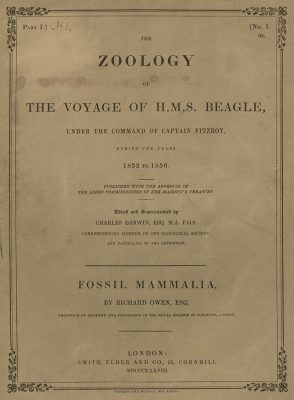Charles Darwin was the foremost authority on evolutionary theory by natural selection. He proposed that different species were all born from one common ancestor and adapted to their environments in an effort to survive and reproduce. An English biologist and naturalist in the 19th century, his ideas regarding evolution were unconventional; however, with his series of publications, he amassed a following that would lead to today’s evolutionary science. He was a prolific researcher and writer, having authored 20 books. In particular, his books that raised his ranking in the naturalist world were Zoology of the Voyage of H.M.S. Beagle, released in 5 parts from 1838 to 1843, and On the Origin of Species, published in 1859. These works discussed the concepts of his theories and examples to justify them.
Zoology of the Voyage of H.M.S. Beagle
While it is not as popular as On the Origin of Species, the book Zoology of the Voyage of H.M.S. Beagle cemented Darwin’s status as a naturalist in his scientific circles. The written work covers his discoveries while on the trip to South America aboard the H.M.S. Beagle from December 1831 to October 1836.
The historian and zoologist Richard Broke Freeman wrote the book’s introduction, describing Darwin’s role in editing and superintending the book of 5 parts and 19 numbers. Darwin also wrote introductions for the first two parts. Part 1 was entitled Fossil Mammalia, written by Richard Owen, a famous paleontologist highly competent in recognizing fossils. The second part was called Mammalia, authored by George R. Waterhouse, a zoologist, and naturalist who examined the animal specimens that Darwin collected on his travels. The ornithologist John Gould wrote the third part, focusing on the bird collection that Darwin had accumulated, describing their habits and different types. Next, the fourth part was written by Leonard Jenyns, who was a clergyman and fellow collector of animal specimens. He analyzed, for his part, the preserved fishes that Darwin brought home. Lastly, the fifth part was finally released in 1843, authored by Thomas Bell, a professor from King’s College, London. The surgeon and zoologist wrote descriptions of Darwin’s collection of reptiles, crustaceans, and amphibians.
On the Origin of Species
Its originally printed title was On the Origin of Species by Means of Natural Selection, or the Preservation of Favoured Races in the Struggle for Life; the book sold out quickly and became one of the most famous biological written works in history. On the Origin of Species detailed Darwin’s theory on natural selection, revealing his reflections from his H.M.S. Beagle voyage. His observations of the tortoises and finches on the Galápagos Islands confirmed his idea that life on earth diverged from one common ancestor. He discovered that species adapted to their environments in an effort to survive and reproduce. Thus, the tortoises had different shell patterns, while the finches had varied colors on some parts of their bodies.
Darwin eventually published six editions of the book, and these are circulated in numerous languages to this day. Important edits that he made were the utilization of Herbert Spencer’s concept of “survival of the fittest” in the fifth edition and his first use of the term “evolution” in the last edition.
Darwin was prematurely prompted to write the book because one of his juniors, the naturalist Alfred Russel Wallace, sent him a paper entitled On the Tendency of Varieties to Depart Indefinitely From the Original Type. While in the Malay Archipelago, the younger Wallace had discovered a phenomenon similar to what Darwin had learned about from the H.M.S. voyage.
Thus, the book was released early and sparked a controversial discussion during Darwin’s period because of the prominence of naturalistic theology and creationist beliefs regarding the origin of life on earth, forwarding that the divine created each species as separate entities designed for a specific purpose. It went against the beliefs of the Christian religion, particularly of the Anglican and Catholic sects. The Bible’s book of Genesis had an entirely different account than what Darwin proposed in his theory.
The Descent of Man
Another noteworthy book by Charles Darwin was The Descent of Man and Selection in Relation to Sex. While On the Origin of Species tackled most other animals such as reptiles, birds, and fishes, The Descent of Man tackled human evolution, writing that much like animals, humans too evolved over long periods. He indicated that primates and humans have similar skeletons and shared behaviors. This is the same in terms of their reproductive processes. Their tissue structure and body hair are also alike. Thus, Darwin believed that the two species are closely related but that humans would find this conclusion difficult to comprehend.
Aside from this shocking revelation to his readers, Darwin also wrote about sexual selection in which males competed with one another for the other sex. Females are also selected by males with different criteria in mind. Both might have sexual conflicts because of their contrasting needs.
